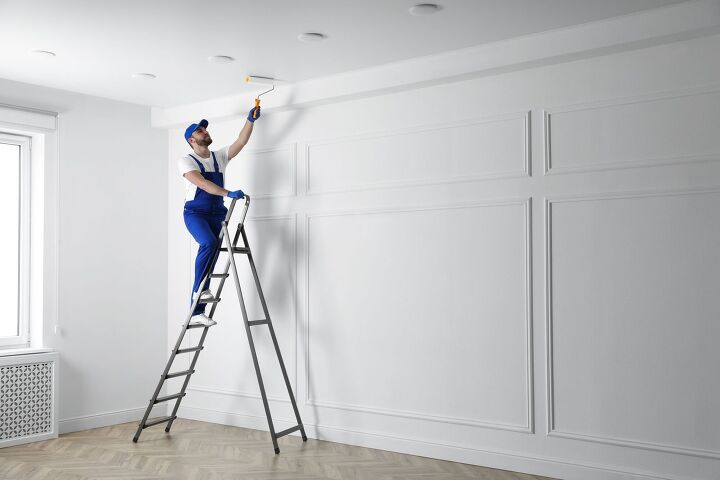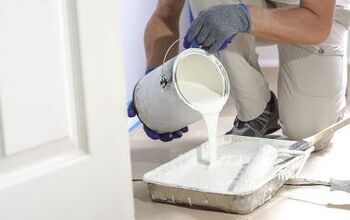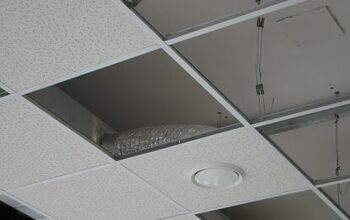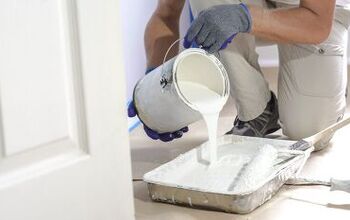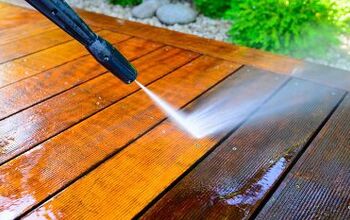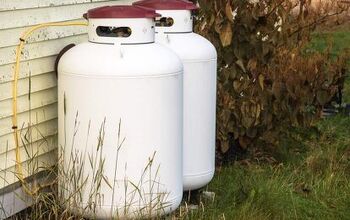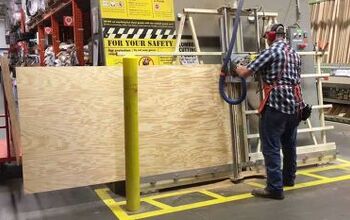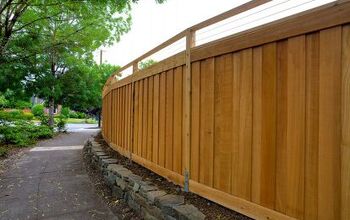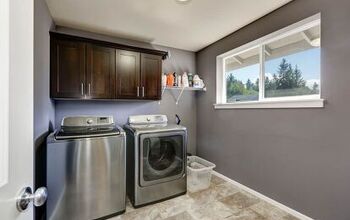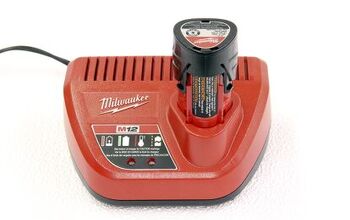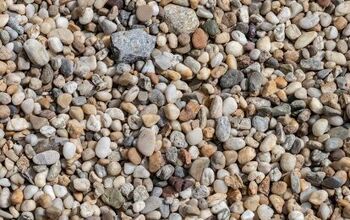Can You Use Ceiling Paint On Walls?

Whether you ran out of paint while painting your walls, or you don’t want to get two separate cans of paint, you might be wondering if you can just use your ceiling paint on your walls.
After all, it’s just paint, isn’t it? Not really; there is more to this than you know!
You can use ceiling paint on your walls, however, you should only use it as a primer, not a finishing or a topcoat.
It’s great at covering up stains and preparing the wall, but you will still need to paint your ideal wall color over it.
We will discuss whether or not it’s a good idea for you to use ceiling paint on your walls so that you can make the best decision for you. You’re the one who has to be happy with the finished product!
Can You Paint Your Walls With Ceiling Paint?
If you’re in the middle of renovating your house, you might have run out of wall paint to finish, but how about ceiling paint? We have done research on the characteristics and applications of ceiling paint over wall paint in order to provide you with a solution.
You can paint your walls with ceiling paint. It is advised to only do this when using the paint as a primer instead of a finish or topcoat. There are benefits and drawbacks of painting the ceiling on the wall, including the following:
- Very few color choices
- You can cover up wall stains
- High durability
Ceiling paint is frequently used on surfaces other than the ceiling. However, it is helpful to grasp the distinctions between wall paint and ceiling paint as well as the situations where each may be more or less appropriate.
Ceiling Paint VS. Wall Paint
The viscosity, or “thickness,” of wall and ceiling paint is their primary distinction. When applied, ceiling paint will adhere better since it is thicker and has a higher viscosity than wall paint.
It is made with more solids in the paint mixture, so that when it is rolled onto the ceiling, it won’t drop or spatter as much.
Additionally, ceiling paint provides more “covering” or use from a single application layer as opposed to needing two or three coats to completely cover a surface.
Not Very Many Color Options
The majority of ceiling paints are made to be applied easily, giving the ceiling a consistent, unadorned appearance.
In light of this, there may not be as many colour options available for ceiling paint as there are for wall paint. However, you may always mix your own paint or have it done at a nearby paint store.
High Viscosity
Because ceiling paint is viscous, applying it results in much less paint mist and drippage.
Applying ceiling paint on the walls can help the painting process go much more smoothly because typical latex paint has a much thinner consistency and requires less time to cure obvious leak areas.
Durable
The exceptional durability of flat paint makes it a popular choice for painting ceilings over semi-gloss or high-gloss paints.
Simply said, semi-gloss paint is less enduring than flat paint, and the slightest scratches can be sufficient to reveal the wall’s full surface texture.
Better At Hiding Stains
The better blocking benefits of ceiling paint’s viscosity make it an excellent choice as a primer for sidewalls and trim in high-traffic areas. It is simple to conceal mildew stains that could appear in a home’s ceiling by painting over the affected areas.
It is a wonderful solution for cleaning rooms that have hand prints, scuff marks, food spills, cigar or cigarette smoke, or other forms of stains. Even though ceiling paint can’t completely hide all stains, it does so much better than standard wall paint.
Is It Worth It To Buy Ceiling Paint?
Depending on the details of your painting project, purchasing ceiling paint can undoubtedly be a smart investment. Even though it’s marketed as “ceiling paint,” you may actually use it on any paintable surface in your house.
It works best in spaces where surface stains might be an issue. Although ceiling paint is a little more expensive than standard latex paint, its better coverage and stain resistance make it a good investment.
What Are The Different Finishes For Ceiling Paint?
Ceiling paint often has a flat white finish, though it can also have an eggshell finish. Why? Because they have the most basic paint textures and allow minimal light to reflect off the surface, which is usually favored in homes and buildings, these sheens are the most common.
Any sheen or glossy finish readily shows up on a ceiling, drawing focus away from the walls or other parts of the room and towards it.
Eggshell Finish
When in doubt about what kind of paint sheen to use, a safe approach is usually to select an eggshell finish.
Eggshell paint, which is regarded as the “go-to” paint sheen, has a very soft appearance and looks well in spaces like family rooms, living rooms, and corridors.
Given that it is more reflecting than a flat sheen but less shiny than a semi-gloss or gloss sheen, this finish is referred to as a low-gloss finish. Sheens with an eggshell finish are equally durable and cleaner than those with a flat finish.
Flat Finish
Sheens that are flat or “matte” make for a silky finish and a generally consistent look. This can be perfect for a home’s formal spaces, such as the dining room and living room.
It is advantageous for matte finishes to have little light reflection because they can be used to cover up wall and ceiling flaws, including holes, dents, and patchwork patterns.
As there is little difference between the newly “touched-up” paint and the remainder of the wall or ceiling surface, they don’t require as many painting applications as gloss or semi-gloss sheens and are quite simple to touch up.
Should You Paint The Ceiling Or Walls First?
Painting from the top down is advised if you intend to paint a whole room in your house. Accordingly, you can paint the ceiling before moving on to the walls and trim.
The rationale is that by painting the ceiling first, you can avoid having to worry about paint splatter, roller mists, or drips ruining freshly painted walls.
The good news is that since you’re already planning to paint the walls, it’s rather simple to fix if this does happen.
Should Walls Be Painted Flat Or Eggshell?
There are common or “typical” uses for each paint sheen, but the homeowner’s preference will ultimately determine which sheen is utilized on which wall or area.
For instance, an eggshell sheen is frequently employed to give trim, kitchens, and foyers a fashionable yet straightforward finish.
It performs admirably in low-traffic areas, and people frequently choose it for office or commercial environments because of its slick, sophisticated surface.
Flat paint’s porous surface makes it rather challenging to clean. A flat sheen definitely isn’t the best choice for painting a room that is more likely to collect dust or debris, hand prints, or excessive humidity.
A flat finish is susceptible to developing stains or mildew patches.
Knowing which sort of paint will be employed in each room in advance is crucial, whether you’re planning a multi-room home makeover or want to touch up a few rooms in your house.
Keep in mind that the paint will shine more and be simpler to clean the higher the gloss the paint has. To put it another way, gloss or semi-gloss paint may be more suitable for the home’s busy or high-traffic areas.
A knowledgeable paint specialist can assist you in choosing the ideal paint sheen for the rooms in your residence if you’re having trouble making up your mind about the best paint option.
Can You Mix Ceiling Paint And Wall Paint?
Do not combine flat ceiling paint with satin wall paint. You should perform a test to determine whether there will be any complications before painting the entire project.
Additionally, we would advise only combining tiny amounts of ceiling and wall paint so that you don’t waste a lot of paint if you do encounter any issues.
What Type Of Paint Is Best For Ceilings?
Each paint has a specific concentration of solvent that thins it down so that it may roll across walls more readily.
According to Home Depot (who I consider paint experts), because you want stronger paint for your ceiling, you should make sure to pick one with no more than 45% solvent when searching for ceiling paint.
Best Types Of Paint For Ceilings
If you ran into the opposite problem and ran out of ceiling paint, below are some of the best choices, designed specifically for your ceiling.
Zinnser Spray Paint
Although Zinnser also sells normal paint, this can of spray paint and primer is intended specifically for use on ceilings. You stand beneath the area that needs touch-up and spray upward with its nozzle to cover it.
Be careful when using this since overspray and drips are easily caused by it. As a result, you should protect everything beneath the locations where you use this spray.
Overall, choosing between ceiling paint and wall paint doesn’t have to be a challenging process. You may locate ceiling paint that will match your ceiling perfectly if you know what shine you wish for it to have.
Kilz Color-Change Stainblocking Interior Ceiling Paint
Kilz is one of the top-selling primer companies and makes a superior ceiling paint called KILZ Color-Change Stainblocking Interior Ceiling Paint. In fact, a ceiling primer will make it easier to fix flaws and spread the ceiling paint more evenly.
This paint applies as a very light pink tint, dries to the touch in an hour, and dries completely in about two hours, at which point it turns white.
Behr Premium Plus Interior Ceiling Paint
Interior ceiling paint by Behr Premium Plus — We adore Behr paint around here. The paint is of high quality, and it is also quite reasonably priced.
If you didn’t really want the ceiling to be completely white, you may tint the Behr ceiling paint to a lighter tone or a milkier white.
Related Guides:

Heather is a passionate writer who loves anything DIY. Growing up, she learned everything from home repairs to design, and wants to share her tips with you. When she's not writing, she's usually hiking or searching for her next DIY project.
More by Heather Robbins



